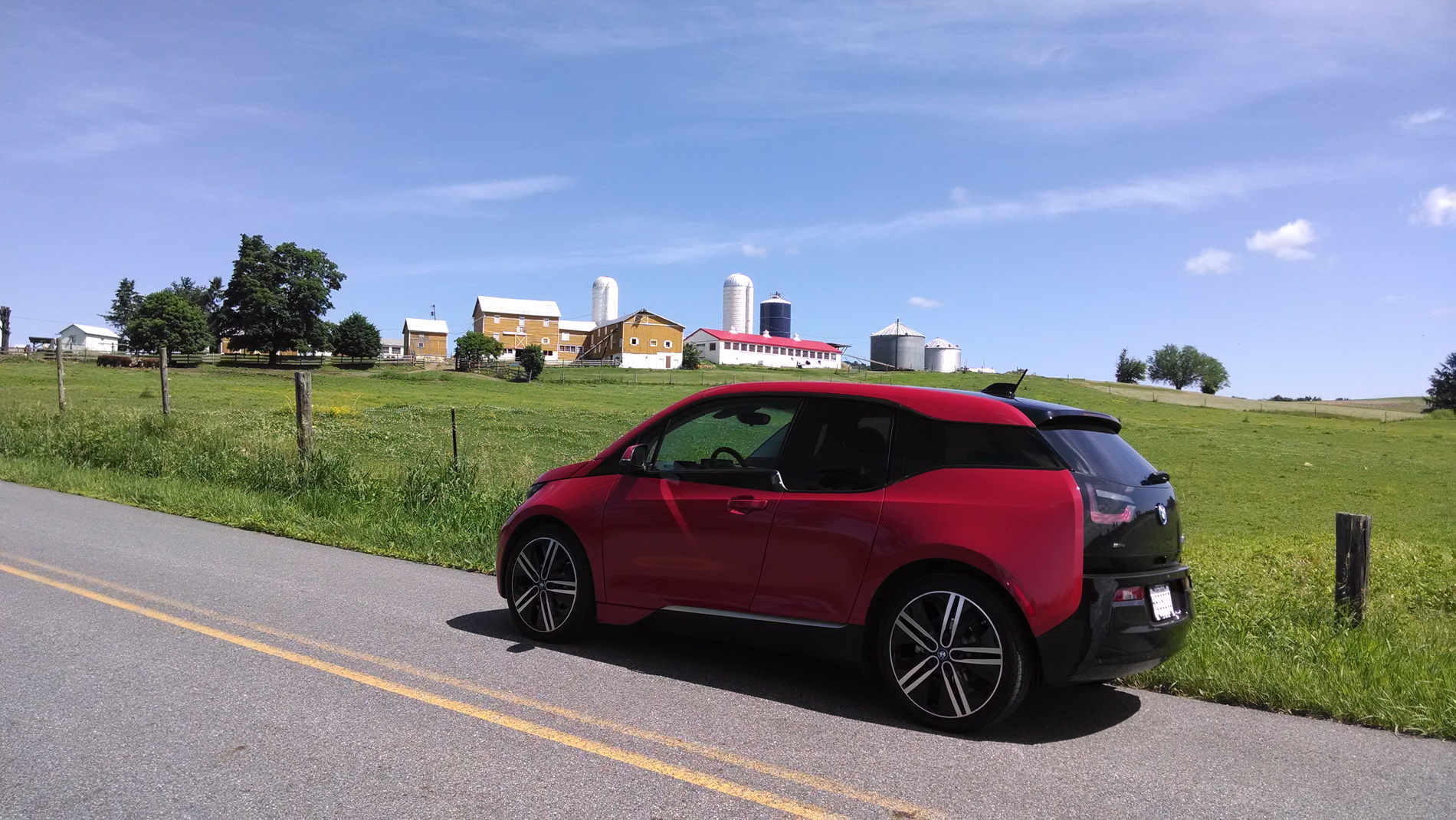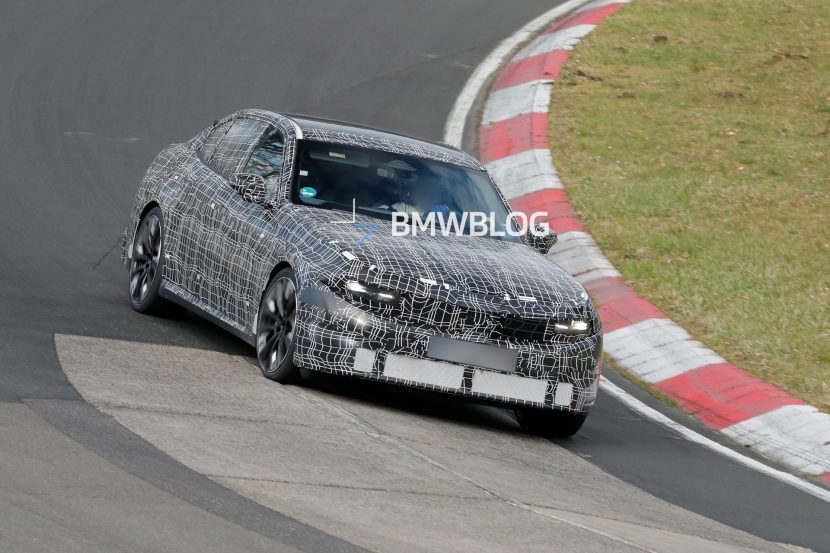I have to say that overall I am very pleased with my i3. It’s living up to what I had hoped it would be, and after a month of ownership I’m convinced it was the right electric vehicle choice for me. However that doesn’t mean it’s perfect. In fact it’s far from perfect, but so is every other car out there. As much as I really love my i3, I can probably list a couple dozen things that I would have done differently. Listed below are some of the top things that I’m not particularly fond of.
The Range. So let’s just get this out of the way now. I’m disappointed that BMW didn’t deliver a real “100 mile” electric vehicle as they had been promising. The 81 mile EPA range on the BEV i3 and the 72 mile rating for the REx, falls a little short in my opinion. If the BEV i3 had an EPA range of 95 miles per charge or greater then I wouldn’t have ordered the REx, and I think a lot of others share that opinion. I hope I’m wrong, but I believe this is going to hold back BEV i3 sales significantly. I think 82 miles falls just short of what many US customers will find acceptable for a premium electric vehicle.
No Proper State of Charge Gauge.When I first found out that the i3 wouldn’t display the state of charge in numeric form, I was dumbfounded. Instead, the i3 state of charge display is just four bars that slowly erode as the range diminishes, and it displays the predicted amount of miles the car “thinks” you can travel. In other words, a Guess O Meter. When Nissan initially offered the LEAF, this is basically the same way they displayed the state of charge. Their customers complained so much, that after a couple years Nissan finally realized they made a mistake and added a proper state of charge display. I dedicated an entire blog post to this back in December of last year when it was revealed that the i3 wouldn’t display the SOC. Still to this day I am in denial and refuse to believe it’s not coming in a future software update. There is absolutely no logical reason for omitting it. It was simply a mistake on BMW’s part and like Nissan they will indeed realize that and add it to the display at some point. I’m not saying they need to eliminate the bar system they have, just give us both and let the customer decide which they prefer to rely on.
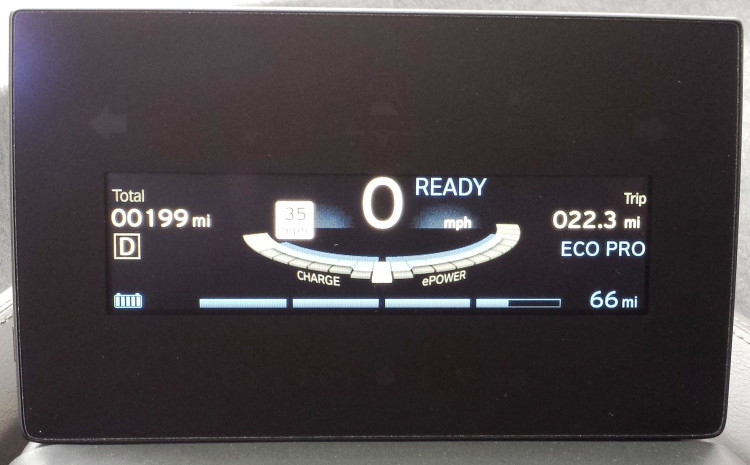
No Battery Temperature Readout. Like the state of charge gauge but to a lessor degree, this is a little puzzling. Maybe the majority of i3 owners might not really care what their battery temperature is, but I do and I know quite a few others who do too. It’s further puzzling because both of BMW’s beta test cars that I drove, the MINI-E and the ActiveE, had battery temperature displays.
I like to see how well the thermal management system is performing, how hot the battery may have gotten while baking in the direct sun of a parking lot for a few hours, or how cold the cells are after parking outside overnight in the dead of winter. Knowing the battery temperature helps me know what to expect of the car performance-wise and can also help me to keep the cells from getting too hot in certain circumstances. The car knows the battery temperature, just provide that somewhere on a screen buried in iDrive somewhere and I guarantee many i3 owners will appreciate it.

Glide Position Difficult to Achieve and Maintain. BMW describes the i3’s glide feature as such: “The BMW i3’s accelerator has a distinct “neutral” position; i.e. rather than switching straight to energy recuperation when the driver eases off the accelerator, the electric motor uses zero torque control to decouple from the drivetrain and deploy only the available kinetic energy for propulsion. In this mode, the BMW i3 glides along using virtually no energy at all.” I’ve only had the car for a month, but it seems more difficult to find the glide (or coasting) position and then hold it, than it was on the ActiveE. A few years ago I was talking with a BMW engineer about this and I suggested there be a switch to turn off regen completely if the driver wished. I would prefer to do this on long, high speed highway driving where I want to coast as much as possible. I was told that they probably wouldn’t offer such a switch to disable it because they would be worried the driver would forget they deactivated the regen, and possibly have an accident because they expected it to engage later on. I still think this would be a good solution for maximizing efficiency by coasting at higher speeds.
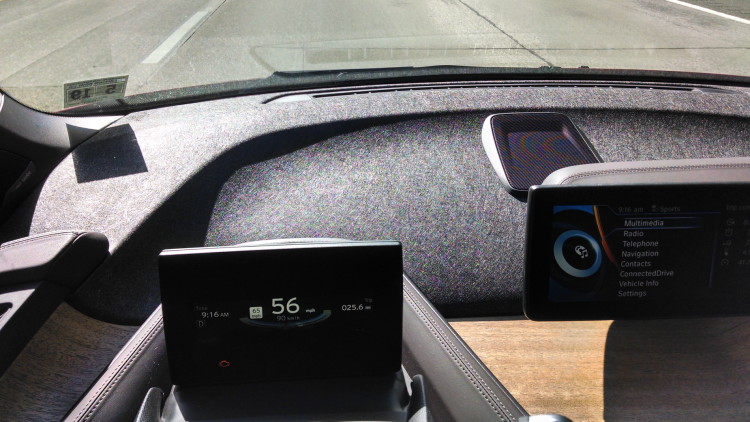

Windshield Glare. The majority of the top deck of the dashboard is made of compressed kenaf fibers. The use of this material has garnered some criticism because some people think it looks cheap, and not worthy of being in a car made by a premium automaker. I actually like the look of it but what I don’t like is that in direct sunlight I can see the reflection of the entire dashboard up on the windshield. After a few weeks I’m getting used to it and it isn’t as annoying as it was when I first noticed it, but it definitely isn’t ideal. The shiny kenaf surface does cast a pretty clear reflection on bright, sunny days.
No AM Radio. I like to listen to AM talk radio and I am a Mets fan (unfortunately). Mets games are only broadcast on AM so I was disappointed to find out that i3 doesn’t have an AM radio. BMW spokesman Dave Buchko recently told Jim Motavalli the reasoning for excluding the AM radio was primarily due to interference from the electric motor: “We learned from our experience with MINI E and BMW ActiveE that the electric motor causes interference with the AM signal. Rather than frustrate customers with inferior reception, the decision was made to leave it off. HD Radio is standard on the i3 and through multi-casting, many traditional AM stations in key markets are available on secondary and tertiary HD signals.” I admit the AM radio in the MINI-E had really bad interference, so much so that I rarely listened to it, but it wasn’t bad on the ActiveE. Other electric cars have AM radios and they don’t seem to be all that bad. This is a little bit of a head-scratcher to me. I’m learning to live without it, but why should I have to?

The Thin Tires Can Get Caught in Pavement Grooves.When roads are paved, unless they are narrow secondary or tertiary roads, they are usually done in multiple strips. This also allows the street to remain open with one lane of traffic flow at a time during the paving process. The problem is, the line where the two sections of the new pavement meet has tiny gaps and over time the road degrades with the help of water and ice and a groove develops. The i3’s tires are so thin that they are effected by these grooves and uneven pavement more so than most cars that are heavier and have wider tires. It doesn’t present a safety problem; the car doesn’t lose any control, you just have to be cognizant of this and make sure you have a grip on the steering wheel when one wheel dips into pavement grooves – which is a good idea in any event. I also believe the very sensitive steering of the i3 adds to this sensation that the grooves are trying to steer the car for you. The i3 has very tight and sensitive steering. You only need to slightly lean in one direction or the other to make a turn, and it is something that takes a week or so to get used to. It has by far the most sensitive steering I have ever experienced on any car. The turning radius is also a freakishly-short 32.3 feet.
Key FOB Doesn’t Open the Hatch. This is a minor complaint, and since my i3 has comfort access I can open the locked hatch just by grabbing the hatch handle as long as I have the key in my pocket. I would still prefer to have a button on the FOB that remotely opens the hatch. There is a button that opens the front trunk, which I will rarely ever need to open, I don’t know why BMW didn’t use that button for the rear hatch, or just add a button and have one for both.
Regen Braking is Less Aggressive. Before I start complaining, let me say that I’ve driven just about every modern electric vehicle and plug-in-hybrid and I believe the i3 has absolutely the very best regenerative braking system on the market. Telsa probably comes in second and the Volt, when driven in low mode, is right behind the Model S. BMW dialed back the regen on the i3 a bit, probably in the vicinity of about 10% when compared to the ActiveE. People who never drove the ActiveE or MINI-E won’t understand what I’m complaining about because the i3’s regenerative braking is still strong and very smooth. It can bring the car to a stop without using the friction brakes faster than any regenerative braking system on any other EV will. Still, I liked it stronger like it was on the ActiveE and MINI-E. I guess regenerative braking is like coffee. Some will prefer the Blonde Roast with cream while others want the Dark Roast served black. Give me my regen as strong as possible please. I recommended to BMW that they offer different regen settings and let the customer decide how strong they like it, but that didn’t come to pass on the i3. It’s still very good, and integrates seamlessly when decelerating, I would just prefer it a bit stronger.

Locking ConnectorWhile charging, the connector is locked to the car as long as the vehicle is locked. The connector cannot be released unless you unlock the doors, even when the charging session is complete. I’ve found this very annoying and so have many other i3 owners. The ability to lock the connector to the car should be configurable in iDrive, giving the owner options like “Unlock when charge is complete” and “Do not lock connector”. Allow the owner to decide what works best for them. Many people like to share chargers, especially in EV-friendly California. These people will leave a note on their dashboard telling others it’s OK to unplug them and use the EVSE once they have finished charging or after a specific time. The locking connector prevents any charger sharing unless you leave your vehicle unlocked, which is not a viable option in most circumstances. I can understand this locking feature would be necessary in Europe because the charging cables are not tethered to the EVSE like they are here in the US and this prevents theft. It seems BMW may have built the i3 for the European charging process and didn’t consider the inconvenience it would cause for US customers. This is another feature I believe we’ll see changed in a software update at some point in the future.
Regen Braking Disengages During Hard Turns. I’m a little surprised with the second complaint I have with the regenerative braking. While negotiating turns, the regen sometimes disengages which will give the sensation that the car is actually speeding up. Of course it isn’t (unless you are going downhill), but when you are in full regen and it suddenly disengages, it does feel like the car is accelerating when if fact it just isn’t being slowed down by the regenerative braking. During the MINI-E and ActiveE programs, I personally spoke to dozens of people who contacted me asking if my car ever suddenly surged ahead. What was happening with those cars was different though. If the regenerative braking system was operating and the car hit a pothole or a bump that caused the wheels to lose traction, the traction control would disengage the regen in an attempt to prevent the loss of control. When this happened, it would give the driver the sensation of sudden acceleration, especially when driving downhill. This was unsettling if you didn’t understand what was happening and typically when this happened the owner would take the car to the dealer for service. The dealer would look it over and find nothing wrong and give it back to them. Frustrated, many of the drivers then contacted me to ask if anyone else had complained of this sudden acceleration problem. After explaining what was actually happening to them they understood what was going on. I would also caution them to always have their foot ready to press the friction brake when they were using regen to slow the car down, especially if they were approaching the car in front of them as they were decelerating.
BMW has indeed improved the whole traction control/regenerative braking system communication and the i3 performs much better than the MINI-E or ActiveE did when the tires lose traction during regenerative braking. However it now disengages during cornering, and neither of its predecessors ever did this. I can tell by how it’s working that it isn’t a flaw in my system, it was intentionally designed to do this, perhaps to prevent the thin tires from losing traction while negotiating hard turns. Again, it’s not a problem as long as you know it’s going to happen and you are ready to use the friction brakes if necessary. I’ve found it mostly happens while I’m taking a highway off-ramp that circles down under the highway overpass. It seems the speed I’m traveling combined with the sharp, constant turn is too much and the traction control preemptively disengages the regen in an attempt to prevent the loss of traction. I believe this is something the dealers need to communicate to the customer. It can be a safety issue if new i3 owners aren’t prepared for it. Just like with the MINI-E and ActiveE, I’m certain there will be customers that believe there is something wrong with their car and will take it to the dealer for service. And just as I’m sure that will happen, I’m sure the service departments won’t have a clue what the customers are talking about and will tell them they checked it out and car is fine. Unless the service manager happens to read this post.
Software Bugs and Various Glitches.There have been a number of various software bugs and other issues reported since the car launched here in the US about two months ago. For example, all of the i3s with the range extender option have had their check engine light (CEL) come on sporadically. Evidently there is nothing actually wrong with the engine, it’s just a software bug and BMW has just released a patch to stop the light from coming on, but it’s still not something you want to see on a new car. I’ve also heard of a couple people have their onboard charger fail, and a few others report that the car flashed a “Drivetrain Malfunction” warning. In the cases I’ve heard about, it just cleared itself and the owner was able to take it to the dealer to be checked and there was no problem found. Honestly I did expect there would be some initial glitches, and it’s really too early to tell if these are isolated cases or if it’s an indication that there are indeed going to be more problems to come. Other than the phantom CEL warning, my car has been perfect so far, but I’ll be watching it closely and reporting on what I experience as well as what I hear from other i3 owners as time passes.
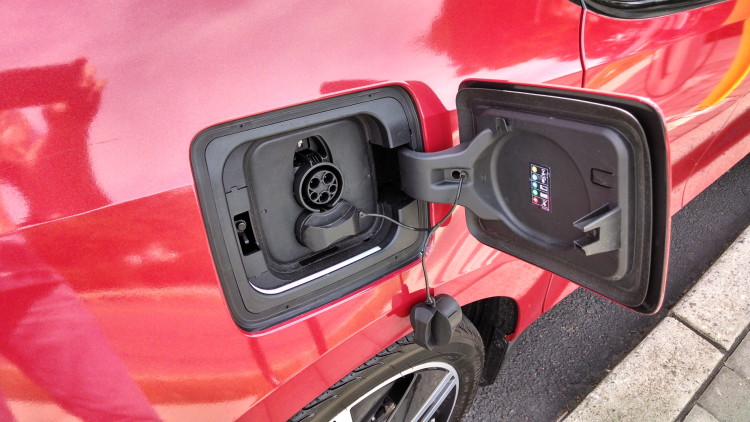
Minor Annoyances:
There are a few things that really don’t bother me that much, but I know other i3 owners who have complained about these things:
1) Charge port plastic caps. After you open the watertight charge port door you need to remove a plastic cap before you plug the car in. It really doesn’t bother me, but I agree it isn’t the best solution. a spring loaded cover that flips over and snaps in place like the ActiveE had would be better. Is this really even needed though?
2) The adaptive cruise control system will sometimes disengage for no apparent reason. When it works, it’s really a great feature, but it does have a tendency to disengage by itself. It seems like driving in the rain, in direct sunlight and going under overpasses give it the most trouble. I have used it a couple dozen times now and it has disengaged four times by itself. Not a big issue, but one that BMW will hopefully improve.
3) The “Door Ajar” warning light is very sensitive. If you don’t close the doors pretty hard, the door ajar warning light will come on while you are driving. The doors aren’t in any danger of opening, I just think the warning trigger is just too sensitive.
4) BMW advertises that for home charging “a maximum charging power of 7.4 kW can be reached”. I have yet to be able to crack 7kW’s and usually see my charge rate at around 6.7 kW to 6.9 kW. Sure, this is a minor complaint, but my supply is more than adequate to accommodate at least 7.2 kW, so why won’t the car pull it? I’ve talked to other i3 owners about this also, and 6.9 kW is about the most anybody has seen the car pull.
5) No programmable button on the key FOB to initiate battery and cabin preconditioning. The European i3s have this feature, but for some reason it was left off the US i3s. You can still initiate cabin and battery preconditioning via the smartphone app, but having it on the key FOB is easier. Some people (you know who you are!) have told me it was a deal breaker and wouldn’t buy an i3 without it.
I’m sure I’ll come up with more dislikes as time goes on, and I’ll continue to post them here. Even considering everything I’ve detailed here, I’m thoroughly enjoying my i3. I drove it a total of 162 miles today and less than 2 miles was with the REx running. The range extender allows me to really push the range limit without worrying if I’ll make my destination. Oh yeah, that reminds me of one more complaint. I want the ability to turn the range extender off if I know I’ll make my destination. Twice so far the range extender turned on when I was less than a 1/4 mile from my house and once it turned on while I was pulling up my driveway! I believe the European i3s do allow the operator to turn it off manually, so that’s just another feature (sunroof, programmable key FOB, REx hold mode) that we don’t get here in the States. Yeah, I know… first world problems.


